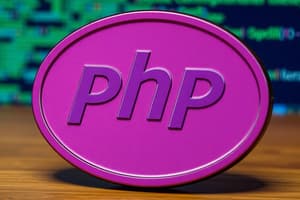Podcast
Questions and Answers
What is the primary function of PHP in web development?
What is the primary function of PHP in web development?
- To style web pages.
- To create dynamic web content and facilitate server-side scripting. (correct)
- To handle client-side interactions.
- To manage database connections exclusively.
Which of the following is a key characteristic of PHP?
Which of the following is a key characteristic of PHP?
- It is executed on the client-side.
- It is a server-side scripting language embedded within HTML. (correct)
- PHP code is directly visible in the browser.
- It is only compatible with specific web servers.
What distinguishes dynamic content from static content in web development?
What distinguishes dynamic content from static content in web development?
- Dynamic content is written in JavaScript, while static content is written in PHP.
- Dynamic content uses only images and videos, while static content uses only text.
- Dynamic content is processed on the client-side, while static content is processed on the server-side.
- Dynamic content changes based on user input or other variables, while static content remains the same. (correct)
Which programming language is commonly used for client-side dynamic content?
Which programming language is commonly used for client-side dynamic content?
What is the role of a PHP interpreter when a server receives a request for a .php file?
What is the role of a PHP interpreter when a server receives a request for a .php file?
How are comments indicated in PHP code?
How are comments indicated in PHP code?
Which of the following is NOT a valid rule for naming variables in PHP?
Which of the following is NOT a valid rule for naming variables in PHP?
What is the purpose of the echo keyword in PHP?
What is the purpose of the echo keyword in PHP?
In PHP, how can you pass information to a function?
In PHP, how can you pass information to a function?
Which PHP function is used to output a variable's value and data type for debugging purposes?
Which PHP function is used to output a variable's value and data type for debugging purposes?
What is the main difference between the == and === operators in PHP?
What is the main difference between the == and === operators in PHP?
Which function is used to define a constant in PHP?
Which function is used to define a constant in PHP?
In an if...elseif...else statement, under what condition is the else block executed?
In an if...elseif...else statement, under what condition is the else block executed?
What is the purpose of logical operators in PHP?
What is the purpose of logical operators in PHP?
What is the difference between using + and . to join strings in PHP?
What is the difference between using + and . to join strings in PHP?
What is an escape sequence and how are they handled differently in single-quoted versus double-quoted strings in PHP?
What is an escape sequence and how are they handled differently in single-quoted versus double-quoted strings in PHP?
Which of the following is the correct way to create an indexed array in PHP?
Which of the following is the correct way to create an indexed array in PHP?
How do you access the value associated with the key 'name' in an associative array called $student?
How do you access the value associated with the key 'name' in an associative array called $student?
What is a multidimensional array?
What is a multidimensional array?
Which of the following is true about PHP sessions?
Which of the following is true about PHP sessions?
In the context of PHP and web development, what does the acronym 'CRUD' stand for?
In the context of PHP and web development, what does the acronym 'CRUD' stand for?
What is the purpose of the PHP function header()?
What is the purpose of the PHP function header()?
What is the significance of the $_GET superglobal in PHP?
What is the significance of the $_GET superglobal in PHP?
Which of the following is a valid way to start a PHP session?
Which of the following is a valid way to start a PHP session?
What does the term 'dependency injection' refer to in the context of PHP?
What does the term 'dependency injection' refer to in the context of PHP?
Which statement about prepared statements in PHP's PDO (PHP Data Objects) is correct?
Which statement about prepared statements in PHP's PDO (PHP Data Objects) is correct?
What is the purpose of the spl_autoload_register function in PHP?
What is the purpose of the spl_autoload_register function in PHP?
What is the difference between require and include in PHP?
What is the difference between require and include in PHP?
In PHP, what is the purpose of traits?
In PHP, what is the purpose of traits?
Which of the following array functions can be used to sort an array by keys?
Which of the following array functions can be used to sort an array by keys?
What is the output of the following PHP code?
$x = 5;
function modify_x() {
global $x;
$x = 10;
}
modify_x();
echo $x;
What is the output of the following PHP code?
$x = 5;
function modify_x() {
global $x;
$x = 10;
}
modify_x();
echo $x;
What is the purpose of the yield keyword in PHP?
What is the purpose of the yield keyword in PHP?
Given the following code, what is the output?
$array = ['a' => 1, 'b' => 2, 'c' => 3];
reset($array);
echo key($array);
Given the following code, what is the output?
$array = ['a' => 1, 'b' => 2, 'c' => 3];
reset($array);
echo key($array);
What will be the output of the following PHP code snippet?
$str = "Hello World";
$newStr = substr($str, 6, 5);
echo $newStr . PHP_EOL;
What will be the output of the following PHP code snippet?
$str = "Hello World";
$newStr = substr($str, 6, 5);
echo $newStr . PHP_EOL;
Which of the following function signatures represents a variadic function in PHP?
Which of the following function signatures represents a variadic function in PHP?
What is the output of the following PHP code?
$text = "This is a string.";
$result = strpos($text, "z");
var_dump($result);
What is the output of the following PHP code?
$text = "This is a string.";
$result = strpos($text, "z");
var_dump($result);
What is the output of the following code?
$num = 10.5;
settype($num, 'integer');
echo $num;
What is the output of the following code?
$num = 10.5;
settype($num, 'integer');
echo $num;
Consider the following PHP code:
$a = 5;
$b = '5';
if ($a !== $b) {
echo 'true';
} else {
echo 'false';
}
What will be the output?
Consider the following PHP code:
$a = 5;
$b = '5';
if ($a !== $b) {
echo 'true';
} else {
echo 'false';
}
What will be the output?
You need to write a PHP function that checks if a given string is a palindrome. Which approach is the most efficient in terms of performance and readability?
You need to write a PHP function that checks if a given string is a palindrome. Which approach is the most efficient in terms of performance and readability?
Which of the following is the MOST accurate description of the difference between json_encode and serialize in PHP?
Which of the following is the MOST accurate description of the difference between json_encode and serialize in PHP?
Flashcards
What is PHP?
What is PHP?
A server-side scripting language embedded within HTML to create dynamic web content.
What is dynamic content?
What is dynamic content?
Modifying content based on user input or other changing conditions.
What is client-side programming?
What is client-side programming?
Code that runs inside the browser to change the webpage without reloading.
What is server-side programming?
What is server-side programming?
Signup and view all the flashcards
What is .php?
What is .php?
Signup and view all the flashcards
What is the 'echo' keyword?
What is the 'echo' keyword?
Signup and view all the flashcards
What is the time() function?
What is the time() function?
Signup and view all the flashcards
What are comments in PHP?
What are comments in PHP?
Signup and view all the flashcards
What are variables?
What are variables?
Signup and view all the flashcards
What is a function in PHP?
What is a function in PHP?
Signup and view all the flashcards
What are arguments?
What are arguments?
Signup and view all the flashcards
What is the 'return' statement?
What is the 'return' statement?
Signup and view all the flashcards
What is the var_dump() function?
What is the var_dump() function?
Signup and view all the flashcards
What are echo and print?
What are echo and print?
Signup and view all the flashcards
What is a constant?
What is a constant?
Signup and view all the flashcards
What is the define() function?
What is the define() function?
Signup and view all the flashcards
What is the == operator?
What is the == operator?
Signup and view all the flashcards
What is the === operator?
What is the === operator?
Signup and view all the flashcards
What is the if...else statement?
What is the if...else statement?
Signup and view all the flashcards
What is the elseif statement?
What is the elseif statement?
Signup and view all the flashcards
What are logical operators?
What are logical operators?
Signup and view all the flashcards
What are loops?
What are loops?
Signup and view all the flashcards
What is string concatenation?
What is string concatenation?
Signup and view all the flashcards
What are double quotes?
What are double quotes?
Signup and view all the flashcards
What is the array() function?
What is the array() function?
Signup and view all the flashcards
What are indexed arrays?
What are indexed arrays?
Signup and view all the flashcards
What are associative arrays?
What are associative arrays?
Signup and view all the flashcards
What are multidimensional arrays?
What are multidimensional arrays?
Signup and view all the flashcards
Study Notes
PHP Basics
- PHP (Hypertext Preprocessor) is a server-side scripting language essential for web development.
- Web developers use PHP to create dynamic content by embedding code within HTML.
- PHP facilitates communication between a website's front end and back end.
- PHP gives websites a dynamic edge, executing scripts on the server before rendering content.
- Dynamic web pages change content based on external inputs such as user searches.
- Two types of web programming languages exist: client-side and server-side.
Client-Side Programming
- Client-side programming executes inside the browser to change content.
- JavaScript is used to change content without reloading the page.
- HTML and CSS cannot generally create dynamic webpages
Server-Side Programming
- Server-side programming executes on the web server; results are sent to the web browser.
- Languages include PHP, NodeJS (JavaScript), Python, and TomCat (Java).
- Server-side code is never visible to the browser as it executes on the server.
Using PHP
- PHP is a server-side language that requires the server to be configured to run PHP.
- PHP's primary task is to generate HTML but can also generate other file types like images.
- With server support, PHP functions by creating .php files in the web directory.
- If the server doesn't support PHP, installation of a web server, PHP, and databases (e.g., MySQL) is required.
- PHP files can be opened with any text editor
- PHP filenames must end with .php to trigger execution by the PHP interpreter.
- PHP can be integrated directly into HTML code.
signals the start of PHP code, andends it.- The
echokeyword outputs a value to the browser. - The
time()function returns the time in seconds since the Unix Epoch. - PHP statements end with a semicolon.
- When requested, PHP code executes on the server, sending HTML output to the browser.
Comments in PHP
- PHP comments provide information or disable code execution.
//and#are for single-line comments; `` is for multi-line comments.
Variables
- PHP variables are containers for storing information
- Data types are automatically assigned to variables.
- Variable names start with a
$. - Variable names must start with a letter or underscore.
- They cannot start with a number and can only contain alphanumeric characters and underscores.
- Variable names are case-sensitive (
$ageand$AGEare different variables). - Strings must be enclosed in quotes; other data types do not need them.
- Variables can store different types of data.
Functions
- PHP functions perform specific tasks and can take inputs (arguments).
- Functions can return a value or display results directly to the browser.
- PHP has over 1,000 built-in functions that can be called directly.
- In addition to built-in functions, custom functions can be created.
- Functions are blocks of code that can be used repeatedly.
- They will execute only when the function is called.
Function Arguments
- Information can be passed to PHP functions through arguments specified inside parentheses.
- Multiple arguments can be added, separated by commas.
Returning Functions
- The
returnstatement is used to return a value from a function. - The dot (
.) operator is used to concatenate strings (e.g.,"echo 1 . 2"prints "12").
The var_dump Function
- The
var_dump()function outputs a variable's value and data type. - The function is useful for identifying a variable's data type or value.
- For strings, the length of the string is also displayed in the output.
Echo and Print
echoandprintproduce output in PHP, withechobeing more commonly used due to its speed and flexibility.- When combined with conditions, they can ensure the desired data is outputted.
PHP Constants
- A constant is an identifier for a simple value that cannot be changed during the script.
- The
define()function creates a constant. define(name, value, case-insensitive)defines the constant's name, value, and case sensitivity.- Case-insensitive defaults to false.
The Equal Operator
- The equal operator (
==) checks that the values match. - The triple equal operator (
===) checks that the values and data types match. - PHP automatically converts data types as required when using
==.
If...Else Statement
- PHP supports
ifstatements similarly to other programming languages.
Elseif Statement
- The
elseifstatement allows for more than two outcomes in anifstatement. - Multiple
elseifstatements can be used;elseis optional but must be at the end.
Combining Conditions
- Logical operators allow the combination and evaluation of conditions.
Logical Operators
- and / && : True if both $x and $y are true
- or / || : True if either $x or $y is true
- xor : True if either $x or $y is true, but not both
- ! : True if $x is false
Loops
- Loops allow you to repeat a block of code multiple times, useful for iterating over data structures.
Joining Strings
- Strings can be joined using
+(adds data types together) or.(concatenates data types). - When adding, PHP converts the string to an integer value and adds it
- When concatenating the string is untouched and joined directly
PHP Quotes
- PHP allows the use of double quotes (
"a") or single quotes ('a') for strings. - Double quotes convert escape sequences and replace variables with their values.
- Double quotes generally preferred due to their functionality.
Creating an Array in PHP
- The
array()function is used to create arrays in PHP.
Indexed Arrays
- Indexed arrays assign each element a numeric index.
- Indexes can be assigned automatically (starting at 0) or manually.
Associative Arrays
- Associative arrays use named keys (strings).
Multidimensional Arrays
- Multidimensional arrays contain one or more arrays and can have multiple levels.
Studying That Suits You
Use AI to generate personalized quizzes and flashcards to suit your learning preferences.




